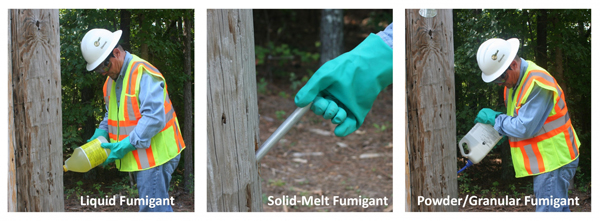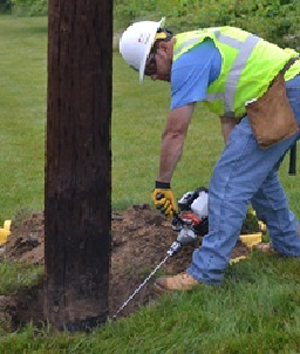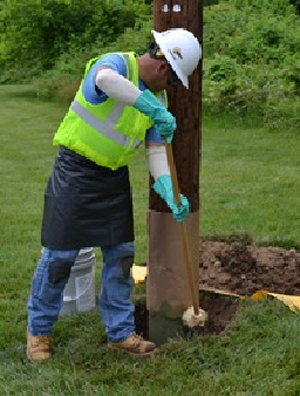Wood Preservative Pesticides
The main types of wood preservative pesticides are: 1) oil-borne, 2) water-borne, and 3) fumigants. The effectiveness of the different chemicals in each of these classes varies depending on exposure conditions.
The three exposure categories for preservatives are:
1) Ground contact (high decay hazard that needs a heavy-duty preservative),
2) Aboveground contact (low decay hazard that does not usually require pressure treatment), and
3) Marine exposure (high decay hazard that needs a heavy-duty preservative or possibly dual treatment).
Some active ingredients can be used in both oil-borne and water-borne preservatives.
The effectiveness of preservative treatment depends on the formulation selected, method of application, proportion of sapwood to heartwood, moisture content of the wood, amount of preservative retained, depth of chemical penetration, and distribution within the wood.
Sapwood of most commercial species accepts preservatives much better than heartwood. Softwood species are generally more receptive to impregnation than the hardwoods. Preservative treatment by pressure is usually required for most wood products used for structure and other applications exposed to high risk of attack by fungi, insects, or marine borers.
Oil-borne Preservatives
These chemicals are generally insoluble in water so they are usually dissolved in petroleum or other organic solvents in order to penetrate wood. Research developments have made available oil-borne preservatives formulated as water in oil emulsions or dispersions in water.
Advantages:
- Toxic to fungi, insects and mold
- Can be dissolved in oils having a wide range in viscosity, vapor pressure and color
- Low solubility in water
- Can be glued depending on the diluent or carrier
- Ease of handling and use.
Disadvantages:
- Can leave an oily, unpaintable surface, depending on the carrier,
- Some applications provide less physical protection to wood than creosote,
- Strong odor is toxic and irritating to plants, animals and humans.
- Dark color,
- Oily, unpaintable surface,
- Tendency to bleed or exude from the wood surface.
Examples are creosotes, pentachlorophenol solutions, and copper and zinc naphthenate.
CCA (chromated copper arsenate) is used for fence posts, railroad ties etc. Creosote is a distillate of coal tar; a heavy oily liquid. Creosote improves the weathering characteristics of wood, provides protection from insects and fungi, and promotes insolubility in water. It is used in railroad ties, large timbers, fence posts, poles, and pilings.
Penta (pentachlorophenol) is a crystalline compound dissolved in light petroleum oil. Products treated with penta include construction lumber and timber, utility poles and crossarms, and fence posts.
Copper naphthenate solution COP-R-NAP (77% copper naphthenate) is diluted with a hydrocarbon solution (diesel fuel, mineral spirits, etc.) for application by brush, roller, immersion, etc. to the surface of poles, pole tops, beams, and lumber to prevent wood decay, termites, other wood attacking insects, and mildew.
[return]
Water-borne Preservatives
This class includes various metallic salts and other compounds. The principal compounds used are combinations of copper, chromium, arsenic and fluoride. Water-borne preservatives are experiencing increasingly wider use for lumber, plywood, fence posts, poles, pilings and timbers.
Advantages:
- No hazard from fire or explosion,
- Wood surface is left clean, paintable and free of objectionable odors,
- Safe for interior use and treatment of playground equipment,
- Leach resistant.
Disadvantages:
- Unless re-dried after treatment, the wood is subject to warping and checking,
- Does not protect the wood from excessive weathering.
Water-borne preservatives are often used when cleanliness and painting of the treated wood are required. Several formulations involving combinations of copper, chromium, and arsenic have shown high resistance to leaching and very good performance in service. Water-borne preservatives are included in specifications for items such as lumber, timber, posts, building foundations, poles, and pilings.
Examples include Acid copper chromate (ACC); Ammoniacal copper zinc arsenate (ACZA), 3 types of chromated copper arsenate (CCA), and others.
[return]
Fumigants
Fumigants are used to control an existing internal decay or insect attack or to prevent future problems. The fumigant, methylisothiocyanate (mitc), is available in products that contain one of three active ingredients - methylisothiocyanate (mitc), dazomet, or metam-sodium. All rely on mitc as the preservative agent. Dazomet and metam-sodium must decompose in order to produce it.

Applying fumigant products (photos: Osmose Utilities Services, Inc.)
Mitc is applied at or near the groundline area in liquid, solid melt, or powder/granular forms. After application, the fumigant volatizes and moves several feet from the point of application under vapor pressure. Fumigants control existing decay fungi and prevent the re-colonization of decay fungi by sterilizing the wood, including difficult-to-treat heartwood.
Methylisothiocyanate (mitc) (MITC-FUME) contains 97% mitc in solid melt pre-packaged individual dose tubes. This approach requires a high moisture content in the wood to be most effective. The dose rate is based on pole circumference.
Dazomet (DuraFume II) is a 98% solid pour granule that decomposes to produces smaller amounts of mitc than MICT-FUME. It is applied in from a metered 1-gallon container. The dosage is based on grams of product per hole and the hole is plugged.
Metam-sodium (WoodFume) is a 32.7% liquid that decomposes to produce the smallest quantities of mitc. It is applied in from a metered 1-gallon container. The dosage is based on pole circumference. For example, one pint of the product is applied for poles with circumferences between 22 and 39 inches.
[return]
Internal Treatments
Borate wood preservatives are composed of naturally occurring minerals that protect wood from fungus, termites, and other wood-decomposing organisms. They are recommended for use in vulnerable, low-lying areas where water is prevalent or rises up from below, especially near masonry or sloping areas that might hold water.

Boring pole to insert rod (photo: Osmose Utilities Services, Inc.)
BOR8 Rods are glass-like solid rods containing 96.65% water diffusible borate wood preservative. Borates are highly diffusible chemicals that help to control wood destroying fungi and insects. When the wood moisture content approaches a level that can support decay (about 25%), the rods dissolve. Borates diffuse along the path of moisture to provide a pattern of protection against future decay.
Copper and boron (Hollow Heart CB Concentrate) contains 5.84% copper and 5% boron designed to be applied by internal injection, brush, or spray.

Applying preservative paste (photo: Osmose Utilities Services, Inc.)
MP 500-EXT preservative paste contains borax and copper. Borax penetrates the wood to control wood decay fungi while copper protects the surface against soft rot fungi.
[return]




